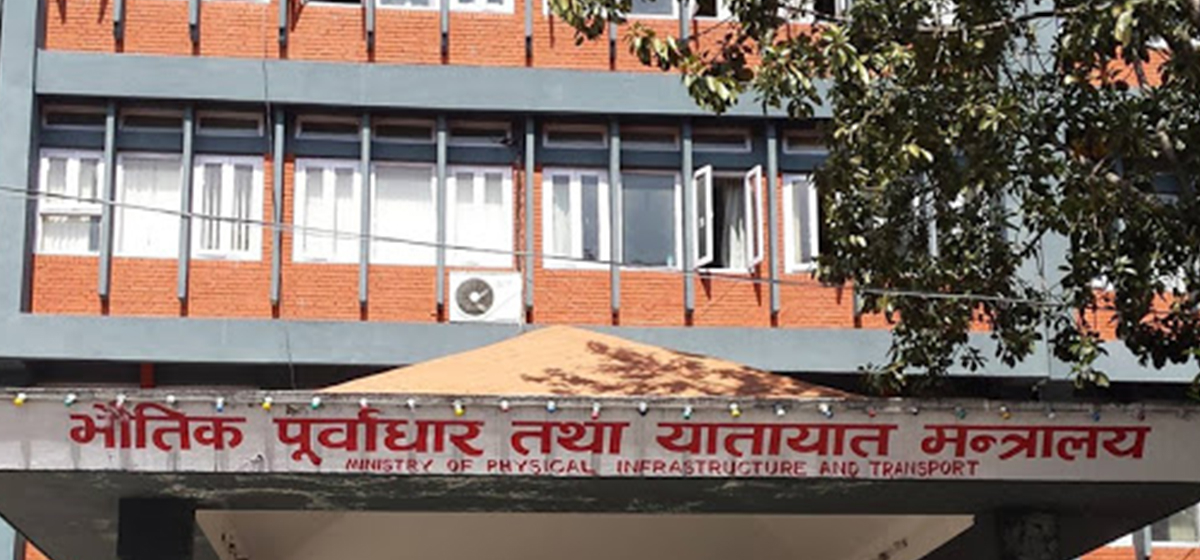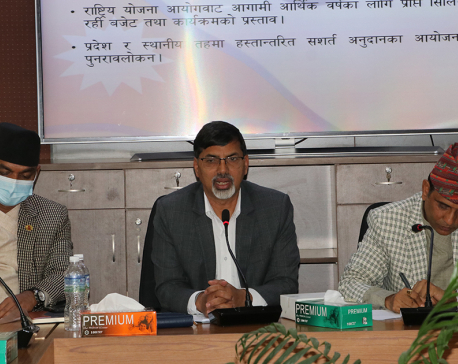
OR
Capital expenditure of Physical Infrastructure Ministry stands lowest in six years
Published On: July 18, 2022 09:15 AM NPT By: Himal Lamsal

KATHMANDU, July 18: The Ministry of Physical Infrastructure and Transport, which has the main responsibility for advancing the developmental projects in the country, has spent only 53 percent of its allocated budget on capital expenditures in the previous fiscal year 2021/22. This is the lowest in the last 6 years. Additionally, the ministry’s expenditure is less this year than that seen during the COVID-19 pandemic.
A majority of the nearly two dozen projects announced by the government as ‘National Pride Projects’ are being constructed by the ministry. As the ministry has spent only half of the target budget, this has also affected the total capital expenditure of the country. For the last five years, the government has been giving more than Rs 100 billion budget to the ministry, saying that it is responsible for the construction of physical infrastructures in the country. However, the ministry has not been able to spend the allocated money so far.
In the fiscal year 2021/22, the government had allocated Rs 156 billion for the ministry, but it had spent only about Rs 82 billion until July 14.
Shiva Prasad Nepal, the spokesperson for the ministry, said that Rs 156 billion had been allocated as capital expenditure in the previous fiscal year for the ministry, but only 53 percent, i.e. Rs 82 billion, had been spent until Thursday.
“In the previous financial year, there was a delay in the release of the budget as a consequence of the replacement bill, and the war between Russia and Ukraine also caused a rise in the price of the commodities which hindered the construction work. All of these factors caused problems in making the capital expenditure,” said Shiva.
In the last 6 years, there were more challenges in the construction work than that witnessed in the previous fiscal year. The COVID-19 pandemic created an environment where people could not go outdoors, but the capital expenditure has been less than in those years.
The 59th Report of the Office of the Auditor General stated that the ministry had spent 90.13 percent of the allocated budget for capital expenditure in the year 2016/17. Similarly, it spent 92 percent in 2017/18 and 76 percent in 2018/19. In 2019/20, the year which saw the onset of the COVID-19 pandemic, the ministry had spent 53 percent as capital expenditure. The physical ministry spent 67 percent in 2020/21, but in the previous fiscal year, it was not able to go above 53 percent.
Ministry officials cite various reasons for the low capital expenditure. They say that this year, the budget was determined later than usual and several party conferences were also held, due to which the environment for working on the projects could not be created. They also argue that it was difficult to work amidst the local elections and the strikes organized by the construction workers opposing the increasing prices.
These claims appear to be mere excuses for failing to make adequate spending. The target set in the budget is not imposed by the government or the Ministry of Finance. The target is set according to the amount demanded by the ministry itself.
The spokesperson of the ministry claims that the tendency of the Nepal government to allocate budgets for the projects without conducting proper studies is also a reason for the low capital expenditure. “The government allocates budget for various projects without the necessary preparation,” he said. “Without completing all the phases in the construction of the projects, the budget cannot be spent within the specified time.”
In the financial year 2016/17, the government allocated a budget of Rs 79.42 billion to the Ministry of Physical Infrastructure and Transport. That year, the ministry spent 90.31 percent of the allocated budget, i.e. Rs 71.73 billion. In the fiscal year 2017/18, the ministry had Rs 103 billion as its budget for capital expenditure where it was able to spend 92 percent, i.e. Rs 96 billion. The ministry had made the highest capital expenditure in the last 6 years in the same year.
In the financial year 2018/19, the government allocated a budget of Rs 119 billion, but that year the ministry spent Rs 91 billion or 76.69 percent of the allocated budget as capital expenditure. Similarly, out of the budget allocation of Rs 139 billion in 2019/20, the ministry spent only 74 billion, i.e. 53.52 percent.
The report of the Auditor General also showed that the average capital expenditure as a proportion of the allocated budget of the Ministry of Physical Infrastructure and Transport in the past four years was 78 percent.
The ministry and the agencies under it spent Rs 93.52 billion as capital expenditure in the year 2021/22 where Rs 59.4 billion, i.e. 63.13 percent of the total expenditure, was spent by the third quarter of the fiscal year while Rs 34.44 billion, i.e. 36.84 percent, was spent in the 12th month of the fiscal year alone. The reports published by the Office of the Auditor General pointed out that the practice of rapid spending at the end of the fiscal year made monitoring difficult, affected the quality of work, led to incomplete purchase and construction processes, and depicted the advances and not the actual costs. Thus, this highlights the need to implement the budget in a way where there is a balanced distribution of the expenditures among the four quarters of a fiscal year.
You May Like This

Birgunj metropolis posts growth in capital expenditure
BIRGUNJ, May 24: The Birgunj Metropolitan City has spent Rs 1.74 billion during the 10 months of the current fiscal... Read More...

FinMin directs officials to mobilize budget to take capital expenditure to 90 pc
KATHMANDU, March 10: Finance Minister Janardan Sharma has directed officials to increase the capital expenditure to 90 percent in the... Read More...

Province 1 spends just four percent of development budget in 1st quarter
BIRATNAGAR, Nov 4: The capital expenditure of Province 1 in the first quarter of the current fiscal year (2076/2077) stood... Read More...





Just In
- NRB introduces cautiously flexible measures to address ongoing slowdown in various economic sectors
- Forced Covid-19 cremations: is it too late for redemption?
- NRB to provide collateral-free loans to foreign employment seekers
- NEB to publish Grade 12 results next week
- Body handover begins; Relatives remain dissatisfied with insurance, compensation amount
- NC defers its plan to join Koshi govt
- NRB to review microfinance loan interest rate
- 134 dead in floods and landslides since onset of monsoon this year












Leave A Comment